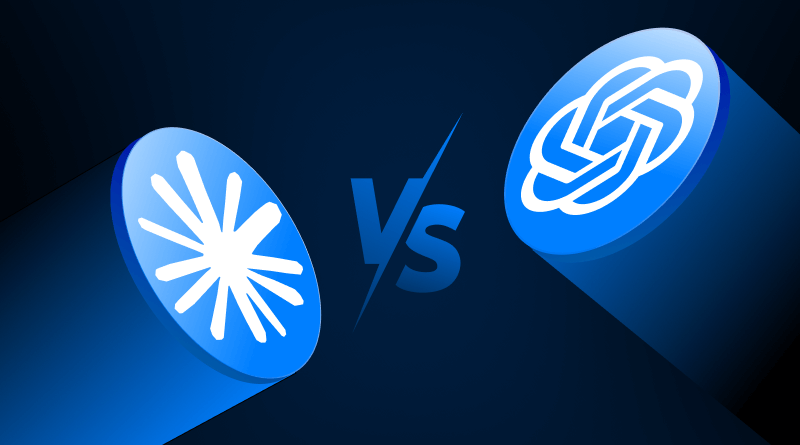AI has put an impact on many sectors and human tasks like writing, creative thinking and more. And the sole reason is not ChatGPT but many other tools. You can create images using ChatGPT image prompts or ask Midjourney or Sora tool to edit videos through AI. While many content writers express concerns about job security due to ChatGPT’s growing presence, the competition among AI language models is intensifying — with Claude.ai emerging as a formidable rival to the most popular LLM (Language Learning Model) ChatGPT.
OpenAI builds ChatGPT, whereas Anthropic PBC develops Claude.ai. Both originated in America, and the launch time of both AI tools is nearby only.
- ChatGPT Launch Date: November 30, 2022.
- Claude.ai Launch Date: March 2023
Both are powerful AI models but with distinguished excellence. Want to know who wins in the Claude vs ChatGPT tussle? Here is the right guide.
Table Of Content
About ChatGPT
ChatGPT is a generative AI tool that allows users to enter prompts to receive relevant results. Videos, images, or textual content are easier to build with this AI tool. It is similar to the automated chatbots that are used in customer service.
Techtionary: GPT stands for Generative Pre-trained Transformer referring to how ChatGPT processes requests and formulates responses. This feedback helps augment ChatGPT with machine learning to improve future responses.
Who Created ChatGPT?
During the pandemic in 2020, the concept of ChatGPT was introduced but with basic features in it. OpenAI has developed ChatGPT in November 2022. It is an artificial intelligence founded by a group of like-minded entrepreneurs and researchers like Elon Musk and Sam Altman in 2015. OpenAI is backed by several investors, with Microsoft being the most notable. OpenAI also created Dall-E, an AI text-to-art generator.
How Does ChatGPT Work?
ChatGPT utilizes specialized algorithms to look for patterns within the data sequences. It originally used the GPT-3 large language model, a neural network machine model and the third generation of Generative Pre-trained Transformer. This transformer pulls from a significant amount of data to formulate a response.
This AI tool uses deep learning, a subset of machine learning, to generate humanized texts. This AI tool is made up of different neural networks. The transformer predicts text, including the next word, sentence or paragraph, based on its training data’s typical sequence.
ChatGPT understands the basics of conversations and converts online texts to human language. It is more customized to perform specific tasks. Humans have the power to rank the conversation response. You can either upvote or downvote the response and train ChatGPT’s AI model.
What Kinds Of Questions Can Users Ask ChatGPT?
ChatGPT responds to complicated or simple questions like “Why Mumbai is the financial capital of India?” or “When was the Gregorian calendar implemented?”. The AI tool is proficient in STEM disciplines and can debug or write the code. Also, there are no limitations to the type of questions asked to ChatGPT. But remember, it can fetch the data till 2023 only.
Related: ChatGPT Prompts For UX Designers
About Claude AI
Anthropic AI has developed Claude, which is both an AI chatbot and the name for underlying Large Language Models (LLMs) power it. Claude excels in some tasks like summarization, editing, Q&A, decision-making, and developing an intuitive dashboard. Moreover, this AI tool is trained to provide updated information upto March 2025 and can read upto 75,000 words at a time.
Who Created Claude AI?
An AI startup, Anthropic, has developed Claude’s AI tool. Ex-OpenAI members co-founded this startup. Founder names like Amodei siblings, Dario and Daniela, were part of the pilot project of OpenAI’s GPT-3 before parting ways due to safety concerns, leading to the inception of Anthropic in 2021.
The Amodei siblings started Anthropic after hiring researchers from OpenAI. The current valuation of Anthropic is $20 billion, supported by significant investments from tech giants like Google and Amazon.
How does Claude AI Work?
Claude AI leverages large language models to understand human-like text. It uses the “Constituitional AI” approach, embedding ethical guidelines into its core functionality to promote safer and less biased outputs. Claude can process vast amounts of text, including documents and images, and excels at tasks like summarization, analysis, and creative content generation.
The training process includes multiple stages of reinforcement learning from human feedback (RLHF). In this process, human trainers evaluate and refine Claude’s responses to align with helpful, harmless, and honest principles. This crucial process helps Claude learn to provide accurate information while avoiding harmful or misleading content. Also, it acknowledges uncertainty when it lacks knowledge about specific topics, making it reliable for users looking for factual information.
Claude’s architecture enables it to maintain context across lengthy conversations and handle complex, multi-step reasoning tasks. Unlike traditional chatbots that rely on predetermined responses, Claude generates original content by predicting the most appropriate following words based on patterns learned from its training data. This allows it to engage in nuanced discussions, assist with coding projects, help with writing tasks, and provide detailed explanations across diverse subjects while maintaining coherent and contextually relevant responses.
Key Differences: Claude vs ChatGPT
Some benchmarks distinguish Claude AI and ChatGPT. Here’s what we have evaluated.
1. Claude Can Process More Words Than ChatGPT
Claude AI has five main active models:
- Claude Opus 4
- Claude Sonnet 4
- Claude 3 Opus
- Claude 3 Sonnet
- Claude 3 Haiku
All these models have a processing capacity of around 150,000 words at a time. While GPT-4 can process 64,000 words, and GPT 3.5 handles only 25,000 words. Claude is considered for a larger context window and input to bigger documents and datasets and then receives more accurate and nuanced answers.
2. Claude Scores Better Than ChatGPT on Exams
Claude AI models outperform GPT 3.5 on academic expertise. It includes the contextual reasoning of an undergraduate and graduate-level student. Claude 3 Opus especially indicates better knowledge and language understanding than GPT-4
According to Anthropic, Opus exhibits “near-human levels of comprehension and fluency on complex tasks,” potentially leading AI’s advance toward artificial general intelligence, the theoretical point where AI can learn and think as well (or better) than humans.
3. Claude Does Not Retain User Data, ChatGPT Does
OpenAI algorithm saves the conversation between the user and the ChatGPT chatbots. It helps them to train their models further. But it also leads to data privacy concerns among individuals and enterprises.
Whereas Anthropic automatically deletes prompts and outputs on its backend within 90 days. Also, they don’t use conversations for training models. So, if enterprises share proprietary or sensitive data during the interaction, Claude AI assures data confidentiality.
Related: ChatGPT Prompts List For Marketing: You Should Use
How to Use ChatGPT?
You can either download a mobile app of ChatGPT or visit its official URL, www.chatgpt.com. You can use its free or paid version as per convenience.
Note: Paid versions allow you to choose the AI model.
- Enter your text, audio, file, or image prompt in the ChatGPT prompt box.
- Enter your text, image, or audio prompt on the ChatGPT home page.
- Once the prompt is entered, you have a handful of options
- Once ChatGPT spits out a response, you have a handful of options:
- Edit your original prompt.
- Enter or say a new prompt.
- Review the sources.
- Copy the response.
- Regenerate the response.
- Like or dislike the response.
- Share the response.
How to Use Claude AI?
- Visit claude.ai, download the Claude mobile app, or use the desktop application, available in both free and paid versions.
- Create an account to get started – paid plans offer more usage and access to different Claude models.
- Enter text prompts, upload files (documents, images, PDFs), or paste content directly into the chat interface.
- Type your question, request, or task in the message box at the bottom of the screen.
- Once Claude responds, you can:
- Continue the conversation with follow-up questions
- Copy the response text
- Provide feedback with thumbs up/down buttons
- Start a new conversation
- Upload additional files for analysis
- Use artefacts for code, documents, and visual content that Claude creates and can modify.
- Integrate Claude through API or use the Claude Code command-line tool for coding tasks.
- Be specific in your requests, provide context, and ask for clarification when needed.
Both Claude and ChatGPT exemplify the advancements in AI technology, as each employs distinct approaches tailored for different users. With a well-established position in the market, ChatGPT performs strongly on general conversation tasks and offers an extensive ecosystem of plugins.
Whereas, Claude is unique with the Constitutional AI philosophy, demonstrating advanced capabilities in document analysis and more intricate reasoning. For many users, the choice is determined by specific requirements: those seeking numerous third-party applications would prefer Claude’s focus on safety, precision, and analysis, while users prioritizing integration would choose ChatGPT.
Comparatively analyzing both tools reveals no conclusive victor; instead, it places emphasis on determining which best fulfils one’s personal needs. It is reasonable to expect that both platforms will continue competing against each other due to their rapid evolution focused on enhancing available features, which could realign their comparative benefits.
FAQs
Which is better for writing content: Claude or ChatGPT?
Both are strong writing AI bots; Claude often leans toward a more conversational, human-like tone, while ChatGPT is known for its structure and factual clarity. It depends on your style preference.
Do Claude and ChatGPT work offline?
No, both require an internet connection. They operate on cloud-based servers, not local devices.
Which AI is better for students and professionals?
ChatGPT is widely used for academic research, coding, and productivity, while Claude excels in writing, summarizing, and idea generation. The best one depends on the use case.
Which understands context better—Claude or ChatGPT?
Both handle context well, but ChatGPT generally maintains longer, more coherent conversations across multiple messages.















